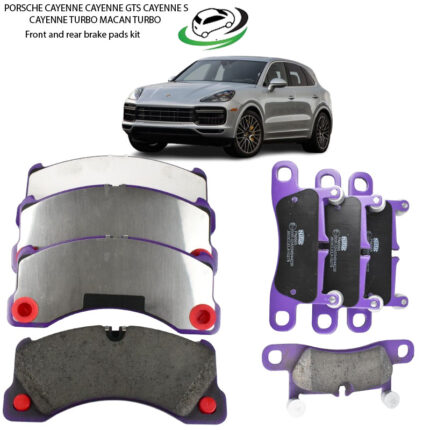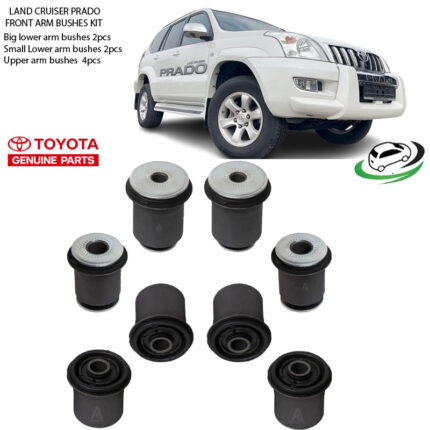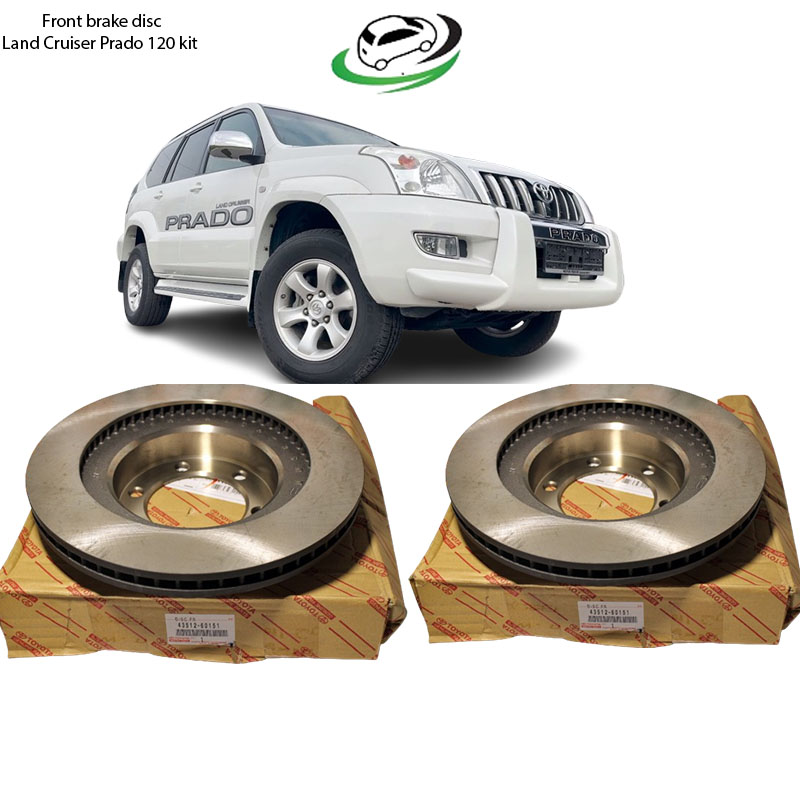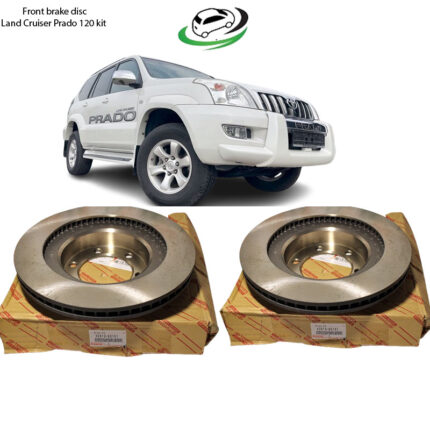-8%
Get Toyota Land Cruiser Prado 120 Series Genuine Front Brake Discs 43512-60151
Front brake discs, also referred to as brake rotors, are crucial components in a vehicle’s braking system, providing the friction necessary to slow down and stop the car. Genuine front brake discs are original equipment manufacturer (OEM) parts, specifically designed to meet the performance, safety, and durability standards set by the car manufacturer. This guide will cover the function, structure, materials, benefits, types, installation, maintenance, and signs of wear for genuine front brake discs, as well as the importance of choosing OEM parts.
What are Genuine Front Brake Discs?
Genuine front brake discs are designed and produced by the same manufacturer as the vehicle, ensuring that they meet all the specific requirements of that model. These discs are made to the exact specifications of the original equipment and are intended to deliver optimal braking performance, safety, and longevity.
Genuine brake discs are built with high precision to fit seamlessly with the vehicle’s braking system, including the calipers and brake pads. They undergo rigorous testing to ensure they provide consistent stopping power under various driving conditions, including high speeds, heavy loads, and emergency braking situations.
Structure of Genuine Front Brake Discs
A front brake disc is typically composed of a flat, circular metallic surface that rotates along with the wheel hub. When the brake pedal is pressed, the calipers force the brake pads against the disc, creating the friction that slows the vehicle. Key components of genuine brake discs include:
- Brake Rotor: The main component, usually made from cast iron or other high-strength materials, designed to endure the heat generated during braking.
- Cooling Vents: Many genuine brake discs are ventilated, featuring internal cooling channels that help dissipate the heat generated from friction. This feature is crucial for preventing overheating and brake fade.
- Mounting Surface: The disc has a mounting surface where it is attached to the wheel hub. It must be perfectly aligned to avoid vibrations and ensure smooth operation.
Materials Used in Genuine Front Brake Discs
Genuine front brake discs are typically made from high-quality materials like cast iron, carbon-ceramic composites, or high-carbon steel. The choice of material depends on the vehicle’s intended use and performance requirements:
- Cast Iron: The most commonly used material for brake discs due to its high heat tolerance and durability. Cast iron provides reliable braking performance for most passenger vehicles.
- Carbon-Ceramic: Found in high-performance or luxury vehicles, carbon-ceramic discs are lighter, more heat-resistant, and longer-lasting than cast iron. However, they are much more expensive and typically not necessary for everyday driving.
- High-Carbon Steel: Offers superior strength and heat dissipation compared to standard cast iron. These discs are often used in sports cars and vehicles that experience intense braking.
Functions of Genuine Front Brake Discs
The front brake discs serve several critical functions:
- Converting Kinetic Energy into Heat: When the brake pads clamp onto the discs, the vehicle’s kinetic energy is converted into heat. This process slows down the wheel’s rotation, allowing the vehicle to stop.
- Dissipating Heat: Genuine brake discs are designed to dissipate the heat generated during braking. Ventilated or slotted discs offer enhanced cooling capabilities, ensuring that the braking system remains effective during continuous or heavy braking.
- Ensuring Consistent Braking: Genuine brake discs provide uniform braking force, which helps maintain the vehicle’s stability during deceleration. Consistent braking performance is essential for preventing skidding and maintaining control, especially in emergency situations.
- Providing Durability and Longevity: Genuine brake discs are manufactured to the vehicle manufacturer’s standards, ensuring long-lasting performance. These discs are built to handle the high levels of heat and stress encountered during braking without warping or cracking.
Benefits of Using Genuine Front Brake Discs
Choosing genuine front brake discs offers several advantages over aftermarket or non-OEM parts:
- Optimal Fit and Performance: Since genuine brake discs are designed specifically for the vehicle, they ensure a perfect fit with the calipers and brake pads. This precision leads to better braking performance and safety.
- Consistent Quality: Genuine parts undergo rigorous testing to meet the manufacturer’s specifications for performance, safety, and durability. These discs are designed to last longer and perform better under various driving conditions than many aftermarket alternatives.
- Warranty Protection: Installing genuine parts often preserves the vehicle’s warranty. Non-OEM parts may void the warranty, leaving the vehicle owner responsible for any damage or repairs that arise from using incompatible components.
- Better Heat Management: Genuine front brake discs, particularly those that are ventilated or slotted, are designed to manage heat more efficiently. This ensures better braking performance, reduces the risk of brake fade, and extends the life of both the discs and pads.
- Enhanced Safety: OEM brake discs are designed with the vehicle’s weight, braking system, and driving conditions in mind. They ensure that the vehicle can stop safely, even in emergency situations, providing peace of mind to the driver.
Types of Genuine Front Brake Discs
- Solid Brake Discs: These are typically found on smaller, lighter vehicles. Solid discs are made from a single piece of metal and are durable, though they may not offer the same level of heat dissipation as ventilated discs.
- Ventilated Brake Discs: These discs feature internal channels that allow air to flow through, helping to cool the disc during use. Ventilated discs are commonly found in larger vehicles or performance cars, where heat dissipation is critical for maintaining braking performance.
- Drilled Brake Discs: Drilled discs have holes drilled into the surface to improve heat dissipation and water expulsion. This type is ideal for high-performance vehicles but can be prone to cracking under extreme conditions if not properly maintained.
- Slotted Brake Discs: Slotted discs feature grooves cut into the surface, which help channel away heat, gas, and debris. These discs are typically used in racing or high-performance vehicles, where maximum braking performance is required.
- Drilled and Slotted Discs: Combining both features, these discs offer improved cooling and braking performance. They are commonly used in sports cars or vehicles that undergo heavy braking.
Installation of Genuine Front Brake Discs
The installation of genuine front brake discs should be done by a qualified mechanic to ensure proper alignment and function. The process generally involves:
- Removing the Old Discs: The vehicle is raised, and the wheels are removed. The caliper is detached from its bracket, allowing the old brake disc to be removed from the wheel hub.
- Installing the New Discs: The genuine brake disc is placed onto the hub, and the caliper and brake pads are reinstalled. Proper torque specifications must be followed to ensure everything is securely mounted.
- Testing: After installation, the vehicle should be road-tested to ensure that the brakes are functioning correctly. The mechanic will check for any vibrations or noises that may indicate improper installation.
Maintenance of Genuine Front Brake Discs
Proper maintenance of genuine brake discs is essential for ensuring long-lasting performance:
- Regular Inspections: Brake discs should be inspected regularly for signs of wear, such as grooves, warping, or excessive rust. If the discs are worn down or damaged, they should be replaced immediately.
- Cleaning: Brake discs should be kept clean and free of debris. Dirt, oil, or brake dust can reduce the effectiveness of the braking system.
- Pad Replacement: Brake pads should be replaced as needed to prevent damage to the discs. Worn pads can cause uneven wear on the discs, leading to poor braking performance.
- Monitoring for Vibrations: If you feel vibrations when braking, it could be a sign that the brake discs are warped or unevenly worn. In such cases, the discs may need to be resurfaced or replaced.
Signs of Worn Front Brake Discs
- Squealing or Grinding Noise: A squealing sound when braking can indicate that the brake pads are worn and are damaging the disc surface. Grinding noises usually mean that the pads are completely worn out, and the metal backing is contacting the disc.
- Vibration or Pulsation: If you feel a vibration or pulsation in the brake pedal when braking, it could indicate that the discs are warped or unevenly worn.
- Visible Damage: Grooves, cracks, or excessive rust on the disc surface are signs that the discs need to be replaced.
- Increased Stopping Distance: If the vehicle takes longer to stop or the brakes feel less responsive, it may be a sign that the discs are worn or damaged.
Conclusion
Genuine front brake discs are essential for maintaining the safety and performance of your vehicle’s braking system. Designed to meet the specific requirements of your car, these discs ensure optimal braking efficiency, durability, and reliability. By choosing genuine parts, you can be confident in their quality, fit, and performance, ensuring that your vehicle’s brakes remain in top condition for years to come. Proper installation, regular maintenance, and timely replacement of worn discs are critical to ensuring safe and effective braking performance.
Follow us on Facebook for more parts.





Reviews
Clear filtersThere are no reviews yet.